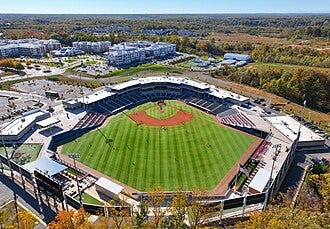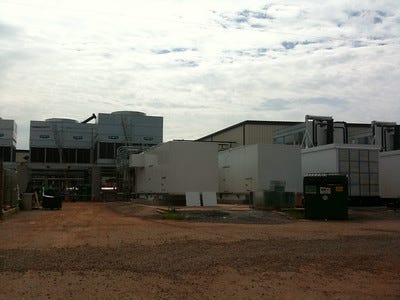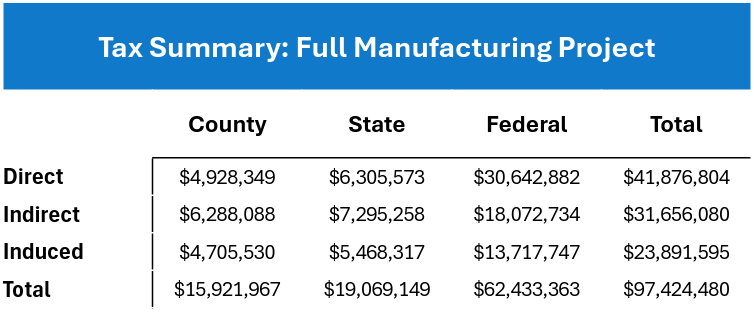DIGITAL INSIGHTS: Baseball, Data Centers, and Economic Development
Do baseball stadiums juice the economy? Yes. And it's easy to see - ticket sales, jobs, food sales, and out-of-town visitors. Data centers juice the economy too, when you know what to look for.
By Martin Davis
EDITOR-IN-CHIEF
Email Martin


With the World Series behind us, local baseball fans are already dreaming about Spring Training and the return of the Fred Nats to Virginia Credit Union Stadium. There, they can sit in the sun with a beer and a dog watching America’s pastime play out.
What they aren’t thinking about are the economic impacts of the stadium on the region.
If asked to do so, however, finding examples to point out wouldn’t be difficult. There were the jobs created when the park was constructed. Then there are the dollars the ballpark itself attracts through ticket and concession sales for the roughly 65 home games played each year. Beyond that, there are also concerts and special sporting events and conferences that are ongoing whether or not the baseball season is in swing.
And then there are the spinoff benefits — visiting fans booking hotel rooms or attending events and dining out — that help to support and sustain the community beyond the ballpark. To borrow developer language, these are the multiplier effects of a stadium in the region.
If you’re asking why a Digital Insights column is talking about baseball — besides the author’s passion for the game — it’s because the description of how a ballpark benefits the community provides a blueprint for better understanding the multiplier effects of data centers.
With ballparks, it’s easy to see the thousands of people moving through ballparks and the surrounding community, spending money that benefits the economy as a whole — from ticket takers to hoteliers and restauranteurs.
Data centers, by contrast, have relatively few full-time workers, making it difficult to understand how they benefit the community as a whole.
Enter Ohio
A new study by Vista Site Selection, LLC — a company that helps businesses across a spectrum of industries locate sites to build — helps explain the multipliers that data centers bring to a region and accompanying benefits to a region.
Focused on the state of Ohio, which currently counts about 200 data center sites in the state, many clustered around the city of Columbus, the study uses real information from data center projects in the state to model a hypothetical data center measuring 250,000 square feet.
The study doesn’t compare this hypothetical project to a baseball stadium, but rather to a manufacturing facility also measuring 250,000 square feet. Comparing these two on a square-footage basis allows for an apples-to-apples comparison.
The study measures three economic impacts of the data center and the manufacturing center in three ways: Direct (measuring operations impact), Indirect (measuring impacts from suppliers to Direct activities), and Induced (re-spending of households from labor markets).
To put that in ballpark language, think ticket and concession sales (Direct), food suppliers and uniform cleaning companies and lighting companies (Indirect), and restaurants and businesses that receive business from people who work for the ballpark and its suppliers (Induced).
When looked at this way, here’s what data centers generate.
The figure above shows the economic impact of one 250,000 square-foot data center measured by the data center’s operations. (Two additional measures will be discussed below.)
The total number of all jobs from the operations side of a data center — Direct, Indirect, and Induced sources — is 181.51, with a total economic output of $49.6 million.
In terms of how much of that money finds its way into the community, $93 million goes to dining, retail, and entertainment, and $265 million finds its way to professional services and commercial services.
How does that stack up to a same-sized manufacturing plant?
The manufacturing sector depicted in the graph above generates more jobs from operations — 716.12 — than does a data center (181.5), but relatively speaking, it generates considerably less economic impact.
Among Direct, Indirect, and Induced sources, $45 million goes to dining, retail, and entertainment ($48 million less than data centers generate), and $109 million goes to professional services and commercial services ($156 million less than data centers).
What’s important to remember is that these numbers are just from the operations side of the businesses.
When one adds in one-time construction impacts and machinery costs over a decade, the gap in total economic impact between the modeled data center and modeled warehouse facility become more pronounced.
Compare the modeled impacts for the data center
with the modeled warehouse
Yes — both are significant economic engines. But comparatively, the data center dwarfs the manufacturing facility.
Tax Revenues
The revenue-generation gap between a data center and a manufacturing facility is as stark when one looks at tax generation.
Let’s start with the modeled data center in Ohio
The figures above are modeled with the one-time construction impacts, ten years of machinery and equipment, and annual labor costs.
One data center in Ohio generates $10 million in direct tax revenue, and nearly an additional $25 million in indirect and induced tax revenue.
At the state level, the Direct, Indirect, and Induced values are roughly equal. And at the federal level the Direct tax impact is nearly $75 million, with the Indirect and Induced costs being slightly lower.
Compared with the modeled warehouse, the difference is significant.
Whereas the total tax impact from the modeled data center is over $233 million, the warehouse generates $136 million less.
Far More Than the People Working in the Building
What gets lost in the economic impact of data centers is the impact as it’s spread across the community.
While data centers will not match a warehouse in the number of jobs it produces on-site, in most every other way, data centers produce significantly more revenue and have a more-profound ripple effect across the economy.
As our region looks to data centers coming online, it is important to look beyond the people with badges going into the doors when measuring their impact on the community.
There are the tax benefits, to be sure. In addition, however, there are the impacts on business suppliers and the employees they hire, and the coffee shops and movie theaters and housing projects and parks and all the other amenities people associate with a healthy community that those who make their living off data center businesses help support.
So when attending a ballgame this summer, remember, economic impact plays out in many ways. Some are just easier than others to visualize.
Local Obituaries
To view local obituaries or to send a note to family and loved ones, please visit the link that follows.
Support Award-winning, Locally Focused Journalism
The FXBG Advance cuts through the talking points to deliver both incisive and informative news about the issues, people, and organizations that daily affect your life. And we do it in a multi-partisan format that has no equal in this region. Over the past year, our reporting was:
First to break the story of Stafford Board of Supervisors dismissing a citizen library board member for “misconduct,” without informing the citizen or explaining what the person allegedly did wrong.
First to explain falling water levels in the Rappahannock Canal.
First to detail controversial traffic numbers submitted by Stafford staff on the Buc-ee’s project
Our media group also offers the most-extensive election coverage in the region and regular columnists like:
And our newsroom is led by the most-experienced and most-awarded journalists in the region — Adele Uphaus (Managing Editor and multiple VPA award-winner) and Martin Davis (Editor-in-Chief, 2022 Opinion Writer of the Year in Virginia and more than 25 years reporting from around the country and the world).
For just $8 a month, you can help support top-flight journalism that puts people over policies.
Your contributions 100% support our journalists.
Help us as we continue to grow!
This article is published under Creative Commons license CC BY-NC-ND. It can be distributed for noncommercial purposes and must include the following: “Published with permission by FXBG Advance.”

















